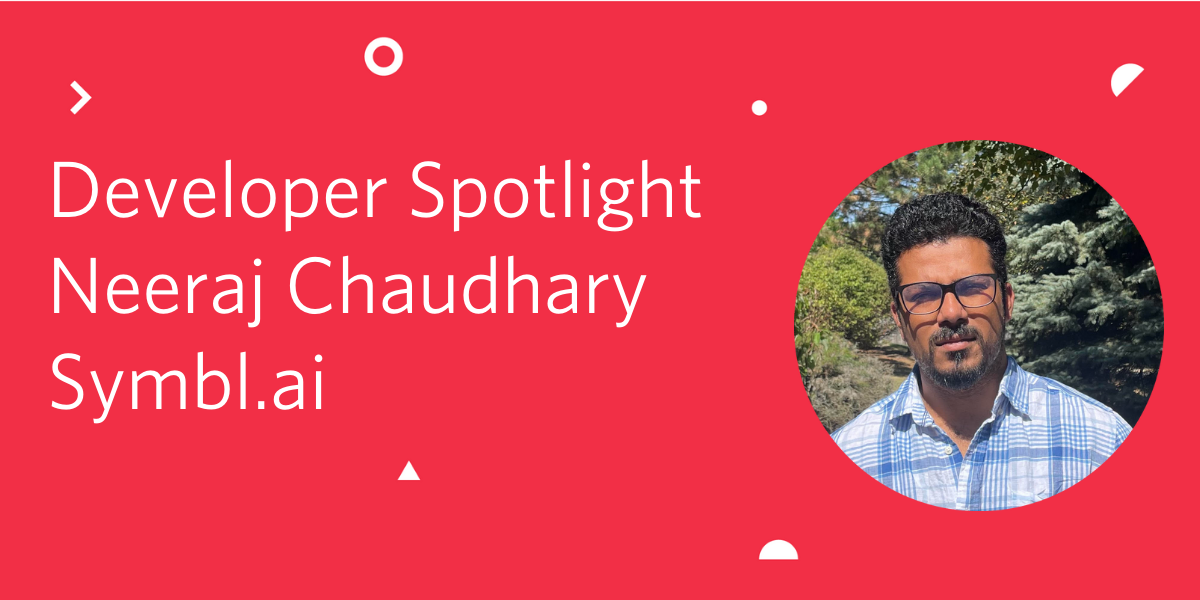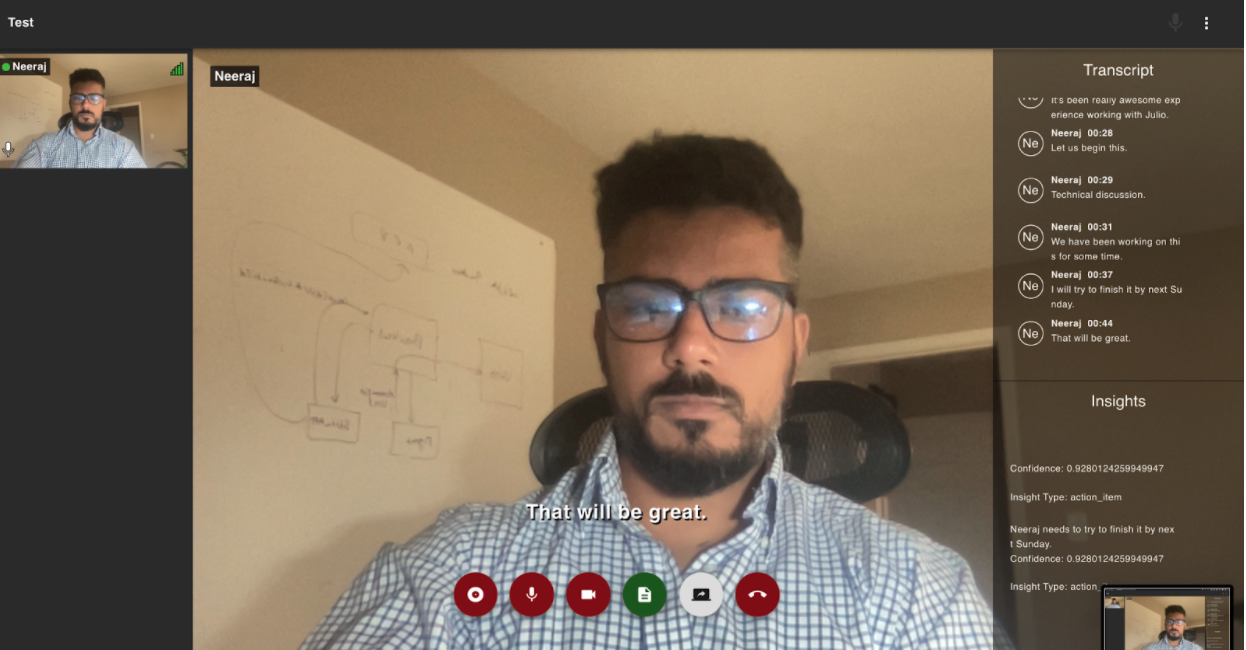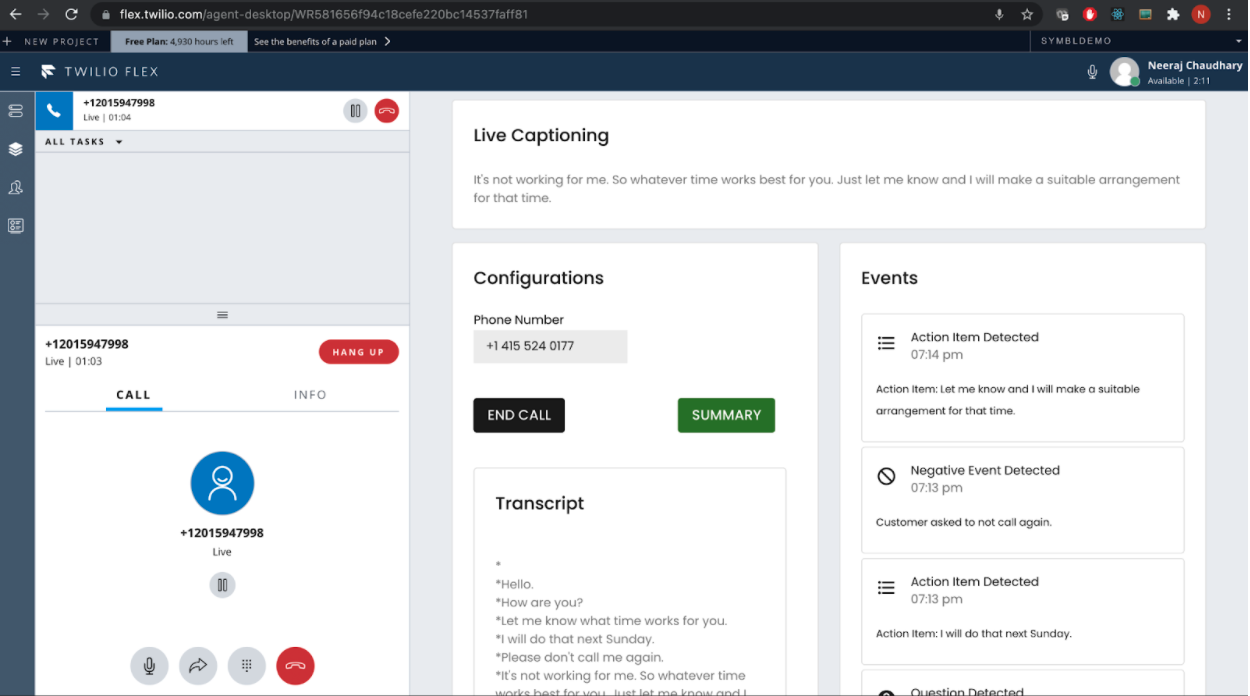Developer Spotlight: Neeraj Chaudhary, Symbl.ai
Time to read: 4 minutes

Too often, app development is siloed from actual use cases. This is a problem Neeraj Chaudhary, sales solutions engineering Lead at Symbl, hopes to solve by working at the intersection of tech and customers from day one. Symbl.ai is democratizing conversational tech to make collaboration effortless at scale. Keep reading to learn what inspired the platform, how they are leveraging Twilio’s APIs and products including Twilio Flex, and what it means for the future of conversational intelligence.
Meet the developer
“I work toward what fascinates me,” says the San Jose-based software engineer. This fascination certainly shines through in the enthusiasm with which he discusses his past and future projects. After falling in love with technology during his undergraduate studies in computer science, Chaudhary worked as a software engineer in India before relocating to the states to continue his work and pursue a Masters Degree from San Jose State University.
At this point in Chaudhary’s 14-year tech journey, his work in the NLP and conversational intelligence space includes designing and building solutions for some of the most prominent next-gen use cases across several verticals, from social to business human interactions on voice and video.
“I love to solve customer problems,” he says, explaining the welcome challenge he faced when he moved from Juniper Networks, where he had worked for three years, to conversational tech startup Symbl. There, clients were using a diversity of communication platforms, reflecting a need for AI-powered conversational tech that provides both actionable insights and the flexibility to meet a range of business use cases.
How the app was born
When Chaudhary joined the Symbl team, the startup was already using Twilio to develop better communication platforms for its clients. Using Twilio’s Video API and SDKs, Chaudhary set to work on building something that would automate the process of analyzing and pulling actionable insights from video communications with customers.
“What we wanted to do was get the video stream from Twilio and send it to Symbl so Symbl could analyze it and send it back to create actionable information.” Because Twilio’s APIs are so clear and easy to use, says Chaudhary, the programming process went pretty smoothly. “Some people are still using it,” he says of the first iteration of the app.
Having found success with the first app, it’s no surprise that Chaudhary was prepared to build a more detailed iteration when a client in Europe wanted to work with Twilio to build a similar platform powered by Twilio’s programmable contact center solution, Twilio Flex, that would allow them to put their customer data to use.
“That process went a lot faster,” says Chaudhary, attributing this to the quality of Twilio’s APIs and the wealth of resources available to programmers using them.
“Twilio is the most mature communication platform that I’ve seen,” he says, emphasizing how quickly he was able to get things done with Twilio. Though he was given two weeks to complete the project, he finished it in just three and a half days. “I started reading Twilio’s API blogs and it actually changed my vision.” Chaudhary says the resources he found on Twilio’s API blogs – and in Twilio’s data repository, which he prefers to plain language resources because he “talks in code” – showed him better approaches that helped speed up the process and resulted in a better final product.
That final product ended up being a contact center agent dashboard with high flexibility for a range of enterprise use cases. The Twilio Flex app works by sending the audio stream taken from a customer call to Symbl to be analyzed in real-time. Then, a report with actionable insights gets sent back to the Twilio Flex dashboard where agents can use it to inform customer solutions.

What sets Flex apart
“With Twilio Flex, you get everything out of the box,” says Chaudhary. “You can just start using it from day one.” For clients, the ability to get to work without an onerous onboarding process is a huge selling point. Yet too often such ease of use can come at the expense of the customizability most enterprises need to make the platform work for them, rather than the other way around.
That’s where Twilio Flex stands out yet again. From a dev perspective, says Chaudhary, Twilio Flex is exceptionally customizable. Flex’s open APIs make it easy to add custom features to the dashboard to fit particular business needs. You get the best of both words – the convenience of a solution that’s ready-to-use plus the flexibility of a solution that’s made-to-order.
In other words, it’s exactly the kind of platform that can be created when programming is both development-oriented and customer-oriented, which is what Chaudhary says he strives for in his work.

What’s next?
Unsurprisingly for a developer driven by a passion for tech, Chaudhary says he’s excited to keep learning more about conversational intelligence. With multiple projects in the works for both Symbl and his Masters studies to look forward to, developers should be just as excited to see where this programmer’s uniquely customer-centric approach takes conversational tech in the years to come.
See it to believe it
Interested in using Twilio to build your own app? Check out the resources in our developer community for inspiration, or sign up for a free trial to start building today.
Related Posts
Related Resources
Twilio Docs
From APIs to SDKs to sample apps
API reference documentation, SDKs, helper libraries, quickstarts, and tutorials for your language and platform.
Resource Center
The latest ebooks, industry reports, and webinars
Learn from customer engagement experts to improve your own communication.
Ahoy
Twilio's developer community hub
Best practices, code samples, and inspiration to build communications and digital engagement experiences.
